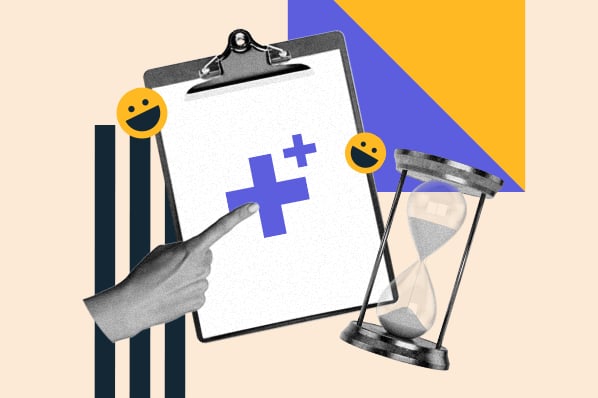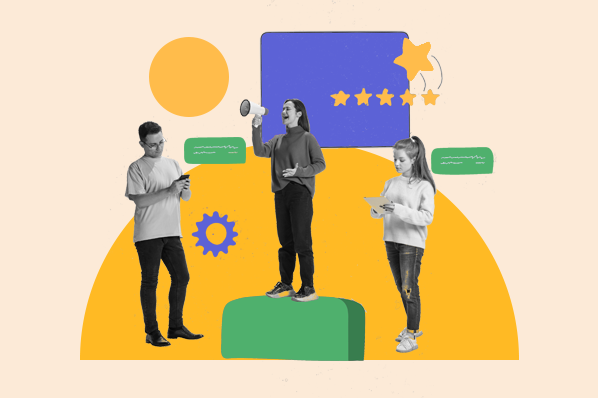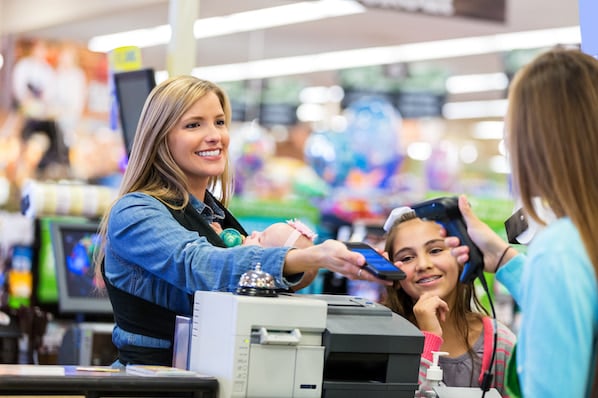Let’s discuss two strategies that help companies retain clients and boost their lifetime value.
Table of Contents
- Customer Loyalty vs. Brand Loyalty
- What is customer loyalty?
- Customer Loyalty Examples
- What is brand loyalty?
- Brand Loyalty Examples
- Why Customer Loyalty and Brand Loyalty Matter
Customer Loyalty vs. Brand Loyalty
There are two types of loyalty — customer and brand. While the former focuses on spending, the latter is about how a customer views or feels about the brand.
You can build customer loyalty by offering lower prices or better deals than your competitors.
Brand loyalty isn’t as simple as it comes down to customer perception. Are your brand values in line with those of your target audience? Do your customers see you as a trustworthy, innovative, and reliable brand?
While these two loyalty types revolve around different aspects (price vs. emotions), they have one thing in common — they both impact customer retention and, therefore, your bottom line.
What is customer loyalty?
Customer loyalty is when a client chooses your product over alternatives because of past experiences with your business.
Other factors that might impact their decisions include tailored promos, attractive loyalty programs, and positive interactions with your customer service team.
That said, your customers might still do business with other brands in your category. Being loyal to a company doesn’t always mean exclusivity. What’s more, your clients might not always feel “emotional” about your brand — they choose you after weighing their options on the market.
Customer Loyalty Examples
There are plenty of tried-and-tested strategies that turn occasional buyers into frequent shoppers. How? Let’s look at three examples from popular brands.
Starbucks
Starbucks was one of the first brands to introduce a global loyalty program as part of its plan to win over coffee lovers’ hearts.
And, it’s not an overstatement to say that it was a successful one. As of 2023, Starbucks Rewards has approximately 29 million active participants, with more than half of the company’s sales coming from this customer segment.
What made the loyalty program successful? Starbucks realized that it needed to provide incentives that were not only attractive but also quickly redeemable.

For each dollar paid by card or cash, clients receive one Star (i.e., point). But if they preload their Rewards accounts and pay via the app, they get twice the number of points.
They don’t need to wait weeks on end to start redeeming prizes, either. With as little as 25 Stars, users can customize their drink with an extra shot of espresso or syrup. Or, if they prefer to wait it out, they can save points and exchange them for merchandise or meals.
Walmart
The retail giant’s customer loyalty initiative, Walmart Cash, is a great example of a “cashback meets rewards” program.
Unlike Starbucks, customers don’t receive points for each and every dollar they spend. Instead, Walmart encourages shoppers to go on a scavenger hunt of sorts.
Cash credits are obtained by purchasing items marked with the “Walmart Cash” icon. Eligible products change regularly and depend on the retailer’s time-limited promotions.
But, what truly makes the program stand out is how points can be redeemed. On top of simply saving up your points for future purchases, clients can also cash out their “Walmart cash” into real-life dollars.

This is a perfect example of how companies can stand out with their customer loyalty strategy in a highly competitive industry, like retail. Since its customers might immediately shop at a different outlet if their prices (or rewards) are more competitive, Walmart understands how frail customer relationships can be.
Its customers aren’t loyal to Walmart’s products. They’re loyal to the customer experiences and the competitive prices that Walmart offers through its rewards programs.
Amazon
As part of its customer loyalty strategy, Amazon decided to explore the power of subscriptions. Its Prime program demonstrates how effective a subscription for bundled products, services, and discounts can be. At the end of 2022, there were over 168 million Amazon Prime members — a number that’s expected to exceed 180 million in 2024.

For $14.99 a month or $139 a year (or less, depending on seasonal offers or the customer’s region), clients get access to free, fast shipping on millions of products, savings programs, and the company’s entertainment platform.
What works in Amazon’s favor here? Customers who lock themselves into a subscription want to feel like they’re making the most of the upfront payment. They may treat the platform as their one-stop shop for every product or service that’s covered by their Prime subscription.
What is brand loyalty?
Brand loyalty is when a customer continues to buy from a company despite changes to its product, services, or pricing. Brand loyalty is a little more nuanced than customer loyalty because it focuses on the intangible, perceived value of your products or business.
For example, someone might choose Diesel jeans over Wrangler — they both sell the same product but the perceptions around these brands are different. Brand loyalty is all about perception — customers might view the former brand as more edgy, and that’s exactly how they want to be seen.
People who are loyal to a brand will intentionally choose it over competitors. Even if it costs them more, they’ll do it because they see a unique value in your brand that other companies can’t match.
This is why brand loyalty is hard to create, but worth the effort. It positions you as a unique brand amongst your competitors.
Brand Loyalty Examples
Let’s see what brand loyalty looks like in real life.
Apple
It’s impossible not to mention Apple when discussing brand loyalty. I bet you’ve seen the never-ending line outside stores whenever a new iPhone comes out.
Apple’s phones are significantly more expensive than its competitors. Yet, millions of people buy iPhones phones each year without even considering an alternative. In 2022, Apple had an astonishing NPS score of 72, which is much higher than the industry average of 43.
How does Apple do it?
First, Apple is an innovator; its product design is sleek and the user interface is friendly.
Second, although customers have to pay a premium price for Apple products, they view them as high quality and reliable. Even if a product breaks, the brand offers great customer support that quickly deals with any issues that arise, making Apple trustworthy.
Third, Apple is known for constantly releasing new products. This creates excitement among its customer base. If someone bought an iPhone a year ago, they still want to get the newest model as soon as it’s launched. In fact, 89% of iPhone holders say they’re not planning to switch brands, meaning their next phone will likely be whatever version of iPhone that’s available to them that year.
Patagonia
Patagonia is an outdoor clothing and equipment company that also has a strong customer following.
It’s recognized for being eco-friendly. It uses recycled materials in its products and encourages clients to try to fix their belongings before buying new ones.
Patagonia also regularly gives financial donations to support environmental causes. Since 1985, it has donated over $140 million to domestic and international environmental groups.

Patagonia is also known for selling high-quality products that are long-lasting, which justifies their premium price. No wonder adventure seekers, who are also committed to protecting the planet, stay loyal to this brand. Their values strongly align with Patagonia’s which is highlighted through its products and its corporate social responsibility.
Whenever you’re searching for something online, what search engine do you use? I bet it’s Google, and don’t worry, you’re not alone.
With its 92% market share, it practically holds a monopoly over search. Google has built high brand loyalty by creating a product ecosystem that users simply can’t resist. A lot of people also rely on Google’s browser, maps, email, and productivity tools in their daily lives. Every new product that Google introduces is in line with its company values, which revolve around accessibility, innovation, and user-centricity.

Combine it all with a friendly user interface, uncomplicated brand experience, and free products, and you get a recipe for a strong brand following.
Why Customer Loyalty & Brand Loyalty Matter
The question isn’t whether customer loyalty is more important than brand loyalty. Depending on what you offer, your industry, and your competitor landscape, it might be easier to generate more revenue from one loyalty type over the other. That said, both are important factors that contribute to a company’s profitability. They must also be built around well-thought-out strategies — not one-off actions.
The process of nurturing customer loyalty is never-ending. You have to continuously research your competitors and observe their purchasing behavior and interactions with your brand.
Customer loyalty is a relatively fragile construct — clients might churn if they notice that they can now get more out of shopping from your competitor.
Ask yourself: How well did your recent promotions go? How many people signed up for your rewards program? Did these (and any other initiatives) grow your customer base?
Brand loyalty is also an ongoing effort. Luckily, once you’ve built an emotional connection and maintained it, they’re much harder to be lured away by your competitors.
Here, it’s less about the price and more about the experience with your services and products. Brand loyal customers are more likely to have a greater customer lifetime value. They’ll continue to buy from your business over time so long as you continue to provide delightful experiences.
Customer and brand loyalty support company profitability.
When working on customer loyalty and brand loyalty, you should turn to different techniques. The same person might be customer-loyal towards a grocery store and brand-loyal in the consumer electronics category. That said, it’s not uncommon for clients who initially prioritize prices to become emotionally connected with your company over time. The key is to show customers that you’re dedicated to meeting their needs with each and every interaction with your business.
Customer Loyalty
.png?width=112&height=112&name=Image%20Hackathon%20%E2%80%93%20Vertical%20(67).png)
-4.png)




-1.webp)


![How & Why Loyalty Punch Cards Attract Customers to Your Brand [+ Examples]](https://53.fs1.hubspotusercontent-na1.net/hubfs/53/customer-loyalty-punch-card_6.webp)


